
This is our guest house, just five minutes walk from the reception of the Sepilok Orangutan tourist centre and six minutes walk to work at the rehabilitation centre.

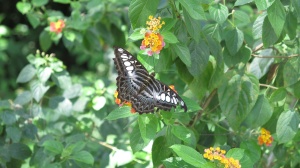
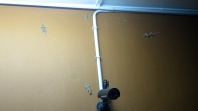

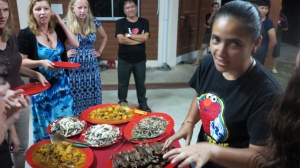
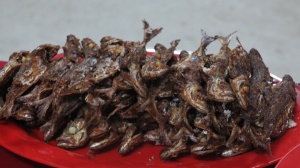

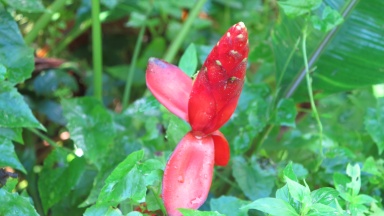
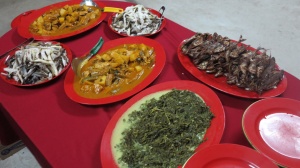

This is our guest house, just five minutes walk from the reception of the Sepilok Orangutan tourist centre and six minutes walk to work at the rehabilitation centre.









Back with the BABIES!
I’ve been so looking forward to seeing the little ones again. Seeing them after being with the older (bigger, heavier) O’tangs they look just tiny! They feel really small too.
There are days here which have been really difficult here. Often uncomfortable in the extreme – sweating all the time, itching from a multitude of mosquito bites
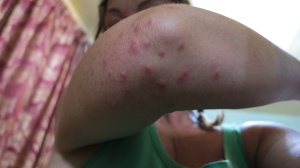
very little privacy, bad food and then there are the questions arising over how things are done here.
I noticed one of the semi-wild Orangutans Miko (a big handsome boy of around 12 years old) was in a small cage (he couldn’t stand up) with another Orangutan. When I asked why, it was because there were not enough rangers on duty.. to be able to keep an eye on everything.
The babies are fed milk powder rather than a specific Orangutan/Primate or even infant powder.. their bottles are sterilised by being soaked in a bucket of tri-gene rather than a proper steriliser.
Don’t get my wrong .. the people here are totally committed to the preservation and love and care for these animals whole-heartedly.. I just wish they had more money to fix things.
It often feels like a mad house at the indoor clinic – Orangutans clanging their cages and crying if they haven’t been out. Rangers yelling if one of the free Orangutans sneaks into the food store or the kitchen. Obviously it wouldn’t be half as much fun for us – but if they just fenced off the clinic, the problem would be eliminated and Orangutans wouldn’t have to be put in cages.
I also hate that the babies are yelled at to climb and threatened with sticks instead of positively encouraging them to cry, by putting food in the trees etc. I guess the argument is that it’s one way for the babies to treat humans with suspicion… Very difficult to do though, especially when these little ones would still be clinging to their mothers. I found the best way to get over this negativity was to think about the alternative – which at this stage is nothing.
This week I had a really bad day…one of those days when the wrong comment from the wrong person at the wrong time becomes the straw that broke that poor proverbial camel’s back.
I was having a quiet snuffle into my mask,
Was quietly crying into my mask trying to collect myself when little Beryl, my adopted Oranga came up to me. I picked her up for an illegitimate cuddle. She gazed into my eyes, not sure what she made of me but there’s no doubting Orangutan’s are empathetic. She touched my face gave me a snuggle… then hopped down to do her roly-poly trick (forward somersault ending in a flat-out on the back finish with arms and legs outspread) then she came back to me to see if her clowning had helped (well that’s how it seemed to me!) Totally adorable.
Gelison was also very cuddly. The mischief-maker who delights in ripping masks off as you walk past his cage, or pulling your hair or your t-shirt if you stand in gripping distance, played with my mask – pulling it down to reveal my face rather than off – then he put his arms around my neck and laid his head on my shoulder. Then he looked up and pulled my mask as if to make me laugh.
Such are the moments that pull you through the tough times and you feel despite how things are/are not done – it’s better than nothing and how privileged we are to spend any time in the company of these incredible beings.
On our last day with the babies they behaved really oddly and out of character. Not a single one of them would climb in the trees. They hung around us all day swinging a bit on the ropes before dropping off so we had to lift them back up. And being all floppy-limbed when you picked them up and not reaching for the rope like they normally do. I held Gelison in my arms and had to giggle as he basically flopped in half, his arms dangling over one of my arms and his legs dangling over the other like a rag-doll.
Beryl and Chiquita were roly-polying. Chiqua sat up in the fork of a tree with her legs dangling ‘clapping’ her feet.
When we put them in their cage it was really sad. Gave them all a kiss (through my mask, through the bars of their cage). We might get to cuddle one of them ONE more time when we get our photos taken. Apparently we’re allowed one photo with one baby, but it’s not clear whether we’re allowed to be holding them or just in the shot beside them. I’m gonna pick the cuddliest baby I can so I’ll get one even if it’s not on film!
Back with Orangutans! Have been missing the babies so much, really looking forward to meeting the slightly older outdoor clinic babies. Although not technically babies, they’re aged 4 to 8 – they’d still be in continuous and very close contact with their mothers til the age of 7 or 8, so they’re still just wee young things to me.
Kasi -fluffy round little buddah. Eats voraciously, using hands and feet to stuff her mouth with as much food at one time as possible. Watching one day I swear I saw her get four banana’s in one go. She couldn’t actually shut her mouth it was so full of banana. Kasi is really independent and usually off in the trees straight away, often stays out over lunch and sometimes overnight. It’s a strange sight to see the silhouette of a tiny Orangutan using vines to climb up the side of towering tree when that tiny silhouette has a huge round pot belly, nearly as wide as she is tall.
Lumiud – another confident climber who likes to swing on the ropes and throw herself about in bushy trees… hear branches snapping and crashing through leaves? That’s Lumiud
Cinta – delicate long-limbed Cinta (which means ‘love’ in Malay). Gentle and lovely, prefers to stay close to the platforms
Matamis – little miss mischief likes to play fight, sometimes goes up in the trees but will often jump off the platforms just to get us to chase after her and make her climb
Kalabatu- Little Mr Mischief. The bad boy you just have to love.
A five-minute walk away from the indoor clinic the ‘outdoor area’ is on the edge of the jungle. There are much bigger climbing platforms and a big hammock made of old firehoses woven together. Ropes connect all the platforms and extend out into some big trees in the jungle.
After prepping their food and cleaning the cages we sat outside to watch the Orangutans and try to tell them apart. The first morning, as amazing as the Orangutans are, was a looooong morning. Sitting and watching for three hours. And it’s baking hot. You’re boots begin to burn you’re feet just because they’re in the sunlight. At one stage we were standing, backed up against the wall in a narrow sliver of shade like sweaty uncool vampires.
By the second day I began to identify individuals apart so it was much more entertaining, really satisfying seeing the next stage of rehabilitation.
Although the Orangs are still kept inside over night and given food morning and lunch and evening, they’re free to go off climbing up huge tall trees in the jungle.
If they don’t want to come in at any stage they’re just left out, but kept track of.
From day one Kalabatu and I had a connection. I walked up to the edge of the hammock where he was lying and he looked me deep in the eyes .. then viciously swiped at my face and snatched my mask of. Gave me a hell of a fright.
A bit later on, all four of us were sitting and Kala swung off the ground and ran at us full tilt. We had no idea what he was going to do but Ruth and I just grabbed him by his hands and feet as he tried to bite us and we hurled him back up into the hammock. He then proceeded to sulk. I hoped he didn’t hate me, so I made sure to give him his bottle at lunch. He didn’t hold a grudge.
Before we take them inside we have to rinse their muddy hands and feet. There’s a tap on a stump. We take the O’tangs by the hand (they usually hold their hands up to be taken) and help them up on the the stump where they sit. They know the routine and when you say ‘ok, give me your other hand’ they understand. We also have to wash our gumboots as well. The orangutans sitting on the stump will often put a hand on one of my shoulders to help me balance. Oh yeah, I’m constantly falling in love.
One day, Kala and I were waiting for the others to wash, it was raining so we sat down next to each other and I put my arm around him to try to shelter him a bit. He snuggled into my armpit and then pushed my elbow off my knee so he could rest his hand there on my leg instead.
If an Orangutan doesn’t want to do something, their primary defence is biting. I’ve been bitten by all the outdoor babies but never hard enough to leave a mark, that’s not to say they don’t/can’t lose control.
One of the rangers got bitten by a scared Orangutan and nearly lost her finger, it was cut down to the bone and she was off work for over 2 months.
Besides all the special ‘moments’ shared with different Orangutans, one of the highlights of the outdoor rotation, was seeing a rehabilitated ape, Clennan, come to the platform at feeding time, with her new baby born in the wild.
I took some photos when we saw her on our first day at Sepilok from the public viewing platform. When she came to the outdoor platform, I didn’t want to antagonise her so kept a reasonable distance, but still got to within about 3 metres of her and her delicate wee infant. Clennan’s hand is bigger than my head but her baby’s head could fit inside my hand. The baby just stares around appearing to slowly take things in with his/her huge eyes. S/he is still to young for the rangers to know what her sex is. And she’s not named yet. One ranger, who is really talented and intelligent suggested Vaneesha (which is how they say my name) I think that’s a really clever idea.

First day and t-shirt’s tucked in, drawstring fastened tight, pants tucked into socks, collars up, all buttons fastened, gators on and coated with insect repellent. Leech proofing is an involved process!
We’re off into the jungle; the Sepilok Rehabilitation Centre sits on the edge of the Kabili-Sepilok Forest reserve – 4856 hectares of primary rainforest.
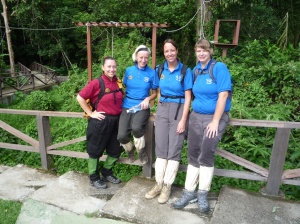
We’re surveying for Orangutan nests. Orangutans make sleeping nests high in the branches of sturdy trees from the age of about 3 years old. Although, at that age the youngsters will just make a small on very close to their mother’s nest. They probably won’t venture further away until 6 or 7 years old.
We need to get at least 300 metres away from the outdoor nursery to ensure any nests we see are not made by the Orangutan’s that have been semi-rehabilitated and occasionally spend the night outside.
We note down the height of the tree, the height of the nest, how old it is (you can estimate by the colour of the dead leaves and how intact the nest is), distance from the trail and what type of tree the nest is in. This data will then be collated on computer to give the centre and overall picture of how many Orangutans are out there and more information on how they’re moving and their habits.
Our guide is one of the rangers, Gabili. He’s very knowledgeable about the flora and fauna and constantly points out different trees and their medicinal uses, animal tracks and identifies the bird calls that echo around us. He learnt a lot of bush lore from his grandfather who used to take him into the bush as a kid.

Although the first couple of days are pretty short – 2 – 2.5 kms, its rough terrain. Climbing over fallen tree trunks (at least the others who’re all tall step over them while do the glamourous sit and swing the leg over) slippery mud, crossing rivers using logs as bridges – very unnerving especially if you think about it too long, 33 degree heat (my t-shirt is wet through in minutes) and lots and lots of leeches!

We’re constantly on the look out for leeches and plucking them off our feet, legs and each other. If you reach out to steady yourself on a branch or tree trunk – you get a leech on your hand or arm. Attempted numerous techniques… pulling (ineffective – they just stretch and stretch and stretch), flicking – works if they haven’t got a good suck on!
Mostly we sprayed them with dettol spray which makes them curl up and tranquillizes them for a few minutes so you can flick them off easily.
LAST DAY TREKKING went on a much longer trek – along a trail that hadn’t been walked for about 2 months. When I say trail… I mean very the path is very clear in some parts but in others, only someone familiar with the area would be able to find their way around.
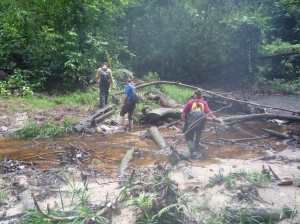
Gabili points out other rangers and trail-walkers marks on the trees and in old logs.
We come across a wide open clearing – after walking for a couple of hours in trees so close only dappled sunlight makes it way through and it’s difficult to make out the trees above 4 metres…entering the clearing is like a hush or momentary pause in the constantly growing, curling, writhing, sucking of the jungle.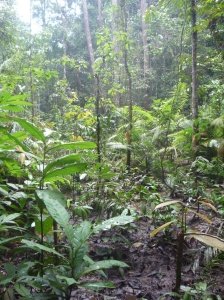
There is marshy ground and sand from a dried river bed. Huge ferns bask in their chance to grow towards the precious sunshine. It felt like a very untouched spot.
Gabili told me the clearing formed when a tree fell and has since rotted away. It must have been massive.
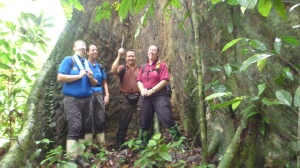
We have seen some pretty big trees and fallen logs though!
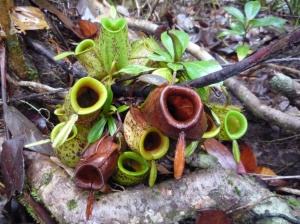
Our destination on this walk was the ‘pitcher plant area’ They only grow in the very middle of the jungle because it’s the only area that’s cool enough.
After 3 hours we got to the water hole. It was really, really hot but the thought of disrobing in the blood-sucking parasite ridden jungle was quite intimidating… but the opportunity to swim in freshwater pool in the middle of the Bornean jungle was just too good to miss.

Clinic week: There are three rotations and my group (2 girls from Netherlands and One English) started our work in the clinic with the youngest Orangutan’s at Sepilok; seven Orangs aged from 1 to 2 -3 years old.
Peanut, Beedo Beedo and Tunduo are the smallest babies aged just over a year old. Beryl, is a wee bit older – she’s my adopted Orangutan. Chiquita is 2, and the boys Gelison and Boogie Boy are just a bit over 2 yrs. They all have very different characters and are all adorable even when they’re being a naughty.It’s been a fantastic week getting to know the babies… and falling just a little bit in love with them.
Every day we start at 8 am – and it’s hot – probably about 36 degrees and extremely humid.
We scrub up, put on gloves and masks to prevent us catching any germs of them and vice versa. Two of us make up the milk, while the other two make up a basket of food.
As soon as the babies hear people around, they start crying. Their cry is a very high-pitched whistling. Almost like a sort of bird call and it can get really loud and piercing when they’re really upset.
The Orang’s smell like wet sheep (but not as strong) crossed with a wet dog. Although that might not sound very nice. The associations I have with it makes it a lovely smell- kind of like cow poo or horse stables.
We take the babies to another outdoor area and then clean their night cages. When you unlock the door to their cage the Orang’s lunge at you in their excitement to get out of their cages, but they always reach for your hand or an arm and latch on. After cleaning the clinic – removing old food and poo, we hose the cages then scrub them all, then hose them again, squeegee the floor then spray entire area with disinfectant. Very sweaty work.
We and the rangers are constantly in and out of kitchen, food storage and enclosure. Everything has locks and grills to stop the released-but-not-keen to-go-too-far Orangutans out. The one occasion you might just slide a grill across and not lock it (- because you’re going back in that room in just a minute) will be the time that Bella will quietly slide the grill across and with her super long arms (adults can have an arm span of around 6 foot) and snake her her hand around the corner and make off with a bottle of Ajax.
Or Michelle or Selamat will sneak into the food store and make off with a bunch of bananas.
It was pouring down with rain, so I wore my poncho to work and carefully hung it up out-of-the-way beside the door.
As I was cleaning the cages I heard a yelling kerfuffle (- this happens pretty regularly, as Orangs get into places they’re not supposed to be… it’s a bit of mad house.) Ibritina, the vet nurse, then told me that Ann had taken off with my poncho – as I looked up and saw her on the roof holding the poncho over her head – I really couldn’t begrudge her.Later the babies dragged it into their cage and beryl pulled a piece with her hands, her feet and her mouth then punched a whole in the middle with her finger. She then put it over head and then pulled her arms through like a little waterproof tutu!
Another time Selamat snuck into the kitchen and seized one of the made up baby bottles. I ran after him and managed to avoid getting bitten as I wrestled it off him with the help of another ranger. SUCCESS! Got it back off him. However, cunningly using the chaos as distraction… little Rosa made her way into the kitchen. I walked in on a very guilty looking ape holding a bottle in each hand and both of her feet, taking rapid swigs out of each in turn. You could see her calculating how long she had before we reached her and she’d have to drop the bottles and bail.
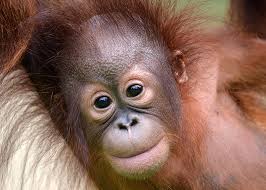
After the cleaning’s done, and if it’s sunny, we start training. We hold the hands of the older Orangutans and walk them down to an area with a lake, a pagoda and some ropes leading to bigger trees.
Chiquita’s a bit lazy and doesn’t like climbing. Found out that she was found when she was very young just three months old and the ranger had to bottle feed her every 2 hours until she was old enough to live at the rehabilitation centre. It explains her affection for people – she loves getting attention instead of climbing into the trees.
Boogie boy is always off and away to the shopping tree (shopping – cos it’s got so much choice!)
When the Orang’s don’t climb and sit on the ground, we have to grab their arms and hand them on the rope or a tree. Then we have to yell ‘Nike Nike’ = climb in Malay.
Chiquita kept climbing down but I suggested we just ignore her because it becomes a game. She sat on an old stump, glancing over to us to see if we were watching her. She then took some of the crumbling wood from the stump and put it on her head… When we didn’t do anything, she brushed it all off. I went down to pick her up for the gazillionth time and couldn’t resist.
She was lying on the ground, so I tickled her under the arm just like a person then when she tried to get my hand away from her underarm, I tickled her tummy and back and forth. She had her mouth open in a big grin… then I stopped and pulled some bit of wood out of her hair. She turned from a mischievous little ape biting and trying not to climb… into a docile little angel. As I was grooming her she looked into my eyes.. The depth of her big brown eyes just made me melt. Oh yes, they’re charming in the extreme.
One day Boogie Boy didn’t even come in for lunch. We left him up the shopping tree. If they’re confident enough to stay out for a couple of hours that’s ok. It is all about getting them back to the trees.